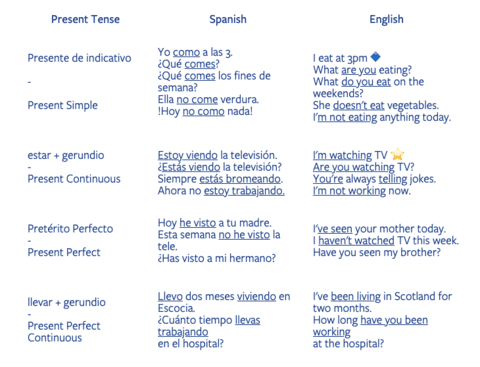Welcome to the first post of the series Easy Spanish grammar for English speakers!
Bearing in mind your feedback, we have selected a series of topics that we will develop in a series of posts. We hope our advice will help you learn Spanish with Lingvist even faster 😉
Let’s get down to business then!

Do you know what a Spanish-speaking person would ask you if he/she wants to know where you are going? He/she would say: ¿Dónde vas? Now, if you translate that literally, you’d say something like this in English: Where do you go?
How come?
Knowing the different verb forms is, of course, very important, but it is also important to analyse the context where we find them.
We think the easiest way to understand these differences is creating a chart where you can find all the equivalences between English and Spanish present tense forms. We have also added some comments that will help you understand those contextual differences we have previously mentioned.
| Present Tense | Spanish | English |
|---|---|---|
Presente de indicativo - Present Simple | Yo como a las 3. ¿Qué comes? ¿Qué comes los fines de semana? Ella no come verdura. ¡Hoy no como nada! | I eat at 3pm🔹 What are you eating? What do you eat on the weekends? She doesn't eat vegetables. I'm not eating anything today. |
estar + gerundio - Present Continuous | Estoy viendo la televisión. ¿Estás viendo la televisión? Siempre estás bromeando. Ahora no estoy trabajando. | I'm watching TV ⭐ Are you watching TV? You're always telling jokes. I'm not working now. |
Pretérito Perfecto - Present Perfect | Hoy he visto a tu madre. Esta semana no he visto la tele. ¿Has visto a mi hermano? | I've seen your mother today. I haven't watched TV this week. Have you seen my brother? |
llevar + gerundio - Present Perfect Continuous | Llevo dos meses viviendo en Escocia. ¿Cuánto tiempo llevas trabajando en el hospital? | I've been living in Scotland for two months. How long have you been working at the hospital? |
🔹 Remember! In Spanish, we use the present simple to talk about habitual actions AND actions happening at the moment of speaking:
-> Habitual: Yo me voy a la cama a las 10 de la noche - I go to bed at 10pm.
-> Right now: ¿Te vas ya a la cama? - Are you going to bed already?
⭐ Important! In Spanish, we use estar + gerund estoy viendo, estas comiendo, etc. to describe present actions that are in progress AND repeated actions. Sometimes you can use the present simple in these cases too.
Please share your questions, comments and/or ideas with us in the comments below!
¡Feliz aprendizaje!




